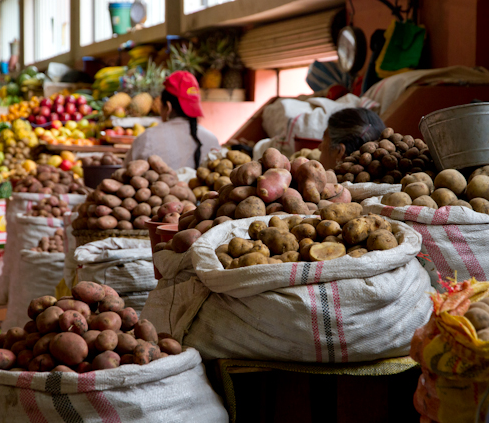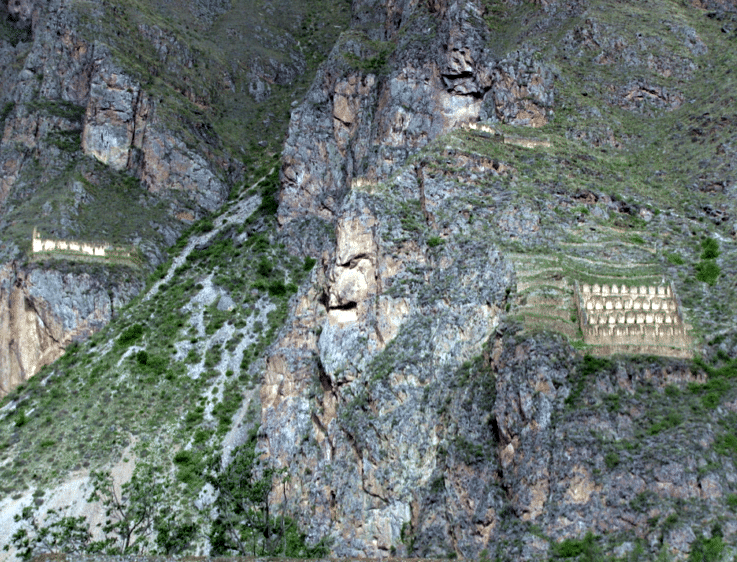The foods of the Americas: The potato changes culinary history forever
Editor’s note: This is the first in a series on notable ingredients native to the Americas that today are influential and essential in cuisines around the world.
By Michelle Bakeman
I was born in Richmond, Virginia. My father is from Buffalo, New York, and my mother is from Viña del Mar, Chile. While I was raised in Virginia, I was fortunate enough when I was young to spend every other summer with my family in South America. It was during those months that my love affair with all things Latin American began.
family in South America. It was during those months that my love affair with all things Latin American began.
I adored the language, the culture, and the feel of Chile, committing to memory year after year the fragrance of her trees and her ocean, the vibrancy of her flowers and fruits, and the taste of her empanadas. Years later, in 2011, I traveled to Machu Picchu, Peru with a dozen of my Spanish students in an effort to illuminate the history and literature that I had taught them, and something magnificent happened. We boarded a bus in the town of Aguas Calientes, which rests some 1,200 feet below the lost city of the Inca.

Michelle Bakeman
As the bus snaked up the mountainside, and I was about to realize my dream of seeing one of the most mystical places on earth, I stared out the window at the lush green foliage, the peaks, the crevices and the streams of the Andean terrain all around us. It was as if Pachamama, Mother Earth herself, were cradling us as we ascended, and I realized that I was home.
Latin America had seeped into the pores of my skin, and she was in my blood. I lasted for less than two more years in Virginia before making my way with my husband and daughter to the beautiful town of Cuenca, in search of a different life. The aromas, flavors, and colors of the Andes have become for me the nourishment of the soul that I had always lacked, and so I wanted to know even more about this fascinating continent and everything she has to offer.
I have been doing research on the foods that were born in the New World, on how they were regarded by those who first cultivated them, how they were intertwined with religion and culture, and everything that happened to them on their journeys around the globe. The moment when the Old and the New Worlds collided was at once the beginning of an apocalypse and at the same time the spark that ignited a “big bang” type of explosion that catapulted goods across the seas. The Spaniards inadvertently discovered something even more priceless than the gold and silver they so coveted; they stumbled upon the foods that would change human history from that moment forward. The most important of those was the potato.
The Potato
Pray for peace and grace and spiritual food,
For wisdom and guidance, for all these are good,
but don’t forget the potatoes.
Taken from “Prayer and Potatoes,” by John Tyler Pettee (1822-1907), Reverend, Poet, and Teacher
The potato (Solanum tuberosum) is a member of the nightshade family, Solanaceae. Per 100 grams (about a quarter of a pound) boiled, it contains 87 calories, is a substantial source of vitamin B6, vitamin C, potassium, niacin, manganese, copper, dietary fiber, and vitamin B5, all essential nutrients. It is considered to be the fourth most important crop in the world, after rice, wheat and maize (some sources say third place, in front of maize, as much of the corn harvest goes to feed animals rather than humans). The word “potato” comes from the Spanish word “patata.”

Cuenca markets sell dozens of varieties of potatoes.
The Spaniards who interacted with the Taíno population in the Caribbean islands were told that their word for the tubers that we now refer to as potatoes and sweet potatoes was “batata.” That combined with the Quechua word for potato, “papa,” perhaps led to “patata.” Quechua was the language spoken by the Inca of the Andes Mountains, and today is the term used to categorize the group of 46 dialects still spoken by over two and a half million people in the region, which spans seven countries.
Research suggests that the papa was growing wild as early as thirteen thousand years ago in the areas that are now Peru and Chile in South America. By close to seven thousand years ago, farmers all over the Andes Mountains were cultivating it, officially domesticating the crop five thousand years ago, by roughly 3000B.C.E.
The clever peoples of these areas quickly began to produce a wide variety of potatoes. One of the tribes, the Inca (the children of the sun), established a capital in a place they called Cusco, which means “navel of the universe,” sometime in the twelfth century C.E. They believed that they were created by the god Viracocha to live on Earth and to worship the sun god Inti, who was their ancestor. These people had a vision that it was incumbent upon them to rule others, to teach them how to grow crops, maintain families, and raise animals, to essentially bring the concept of civilization to the tribes that surrounded them. They, therefore, began to conquer their neighbors.
By the time the Inca dominated the region (best estimates say the mid-1400s), its people were building an empire that eventually stretched from northern Ecuador to beyond present-day Santiago, Chile. Local farmers were busy cultivating no less than 3,000 varieties of potatoes, specifically tailored to thrive in the spectrum of terrains along the western side of South America, at varying altitudes and soils, and exposed to different levels of rainfall and sunlight.
It is important to acknowledge that to label the collective populations of this region as Inca would technically be a misnomer. The Inca were the ruling tribe, the elite of the time, controlling a vast array of other peoples. The same can be said of the Aztecs of Mexico who were the reigning group over many at the time of Hernán Cortés’ arrival to the New World. At the moment of the encounter of the Inca with Francisco Pizarro in 1532, the percentage of the population that was, in fact Inca, was small, numbering around 40,000, even though the Inca ruled over somewhere between twelve and sixteen million people, having absorbed the populations of tribes such as the Sora, the Rucana, the Chanca, the Chimú, and the Chacapoya (known as the “warriors of the clouds”) to name a few. That said, for our purposes here, I will refer to the Inca and to the Aztecs with the understanding that the label embodies so much more.
Archaeologists have discovered potato remains that date back to 500B.C.E. in the ancient ruins of Peru and Chile. Ancient peoples explored different cooking methods for the crop, boiling them, baking them, and even mashing them as we do now. As the Inca were striving to create a sedentary civilization and always preparing for either periods of famine or war, they began to construct storage units for potatoes to ensure easy access to them in the event of some unforeseen catastrophe or in the event that they needed to assemble them quickly for long journeys.

Storehouses embedded in the mountain above the town of Ollantaytambo, Peru. Notice the rock in the center that looks like the face of an angry man. It is said that the storehouses were placed here deliberately in the hopes that the angry man in the rock would stave off raiders.
Over time, the Inca realized that by extracting the moisture from raw potatoes, which consist of 80% water, they could, in fact, preserve them. Have you ever left a vegetable like spinach or a cucumber in a refrigerator that was too cold? What happens when they begin to freeze and then thaw again? They become water-logged, soggy. The Inca of the altiplano (the highlands of the Andes) employed a method to freeze-dry potatoes. By exposing them to the nighttime freezing temperatures at high altitude and then, as they thawed in the sunlight of day, by pressing out the moisture, and repeating the process several times, the Inca created a new product, called chuño. Chuño is a shrunken potato, now dark-colored, small, light-weight, and once reconstituted in water, possessing of all its original nutrients.

A Peruvian woman cooks potatoes in traditional earthen oven.
This ingenious version of the potato lasts for up to five or six years stored underground. One could make the argument that chuño alone secured an empire, or at least the idea of it, as its population could count on sustenance regardless of any unforeseen circumstance. There is even evidence that chuño was used as currency and demanded by the Inca as tribute by those conquered. So protective were the Inca of the potato that they often mentioned it in prayer, and so sacred were the potatoes that they were buried alongside the dead in preparation for the afterlife.
What did the Inca believe about the origin of the potato? The truth is that they were uncertain. They claimed that the potato was an old creature, existing before the time of the first Incas who were placed on the land by Viracocha. One legend mentions that when Viracocha created the first male and female Inca, named Manco Capac and Mama Ocllo, and pulled them out of Lake Titicaca along with the sun and the moon, one of the first things he did was to teach them how so sow potatoes so that they could go forth and teach others.
The Inca had a pantheon of gods and spirits, and those deities responsible for anything related to farming were feminine and were called “mamas.” Pachamama is the greatest of these. She is considered to be “mother earth,” and is the mother spirit of the mountains, rocks, and plains. Mama Quilla, one of her daughters, is the Inca goddess of the moon. The Inca explained the existence of silver upon the earth as the fallen tears of Mama Quilla that had embedded in the rocks. According to one legend, it was the moon that blew across the earth, her breath creating the first potato.

More than 4,000 varieties of native potatoes grow in the Andean highlands of Peru, Bolivia, and Ecuador.
Pacha mama had other daughters as well, namely Quinuamama (quinua-mother), Saramama (maize-mother), Cocamama (mother of the coca plant), and of course, Acsumama or Axomama, who was the potato mother. It was common practice for villagers to have idols representing these spirits for worship and sacrifice, such as an oddly-shaped potato kept to symbolize Acsumama or an ear of corn carved in stone to represent Saramama. These feminine forces were revered but also feared by the Inca, especially Pachamama, who could be notoriously ill-tempered, particularly if she were made to feel taken for granted, her plants and animals abused or neglected, her gifts of food not appreciated. In such circumstances, she sought revenge in the form of earthquakes and landslides.
Careful to keep Pachamama content, then, the Inca went about the business of growing potatoes, prolific in their obsession with creating new varieties to withstand the vast terrains and climates throughout their empire. Today there are over 4,000 kinds of potatoes native to the Andean highlands of Peru. The descendants of the peoples who first started cultivating them still do, small farmers usually producing at least ten varieties each, some of which are never sold but rather traded at local markets for others. They often bestow the names of family members on new types of potatoes, to that degree showing their respect for this crop. Potatoes are still today, for the Andean people, as precious as gold.
____________________
Michelle Bakeman has a bachelor’s degree from the University of Virginia in Spanish and Latin American Studies. She is also a graduate of the Culinary Arts Institute of Louisiana. She has been a chef for twenty-two years, has owned and operated several restaurants, and has been a teacher for sixteen years. She moved to Cuenca in 2013.
Sources:
Ancient History Encyclopedia. (Ancient.eu). Inca Civilization.
Earthstoriez.com. Bolivia: On the Origins of PAPA (potato).
CuscoEats.com. Food and Culture of the Andes. Incas Come from the Ground like Potatoes.
LatinAmericanStudies.org. A History of the Incas.
Saveur.com. How a Peruvian Farmer is growing 180 Kinds of
Potatoes.
Smithsonian.org. The Inca Road. The Fascinating Afterlife of Peru’s Mummies.
Spence, Lewis. Cosimo Classics. 2010. The Myths of Mexico and Peru
Standage, Tom. Bloomsbury. 2009. An Edible History of Humanity
WhatsCookingAmerica.net. History of Potatoes.






















